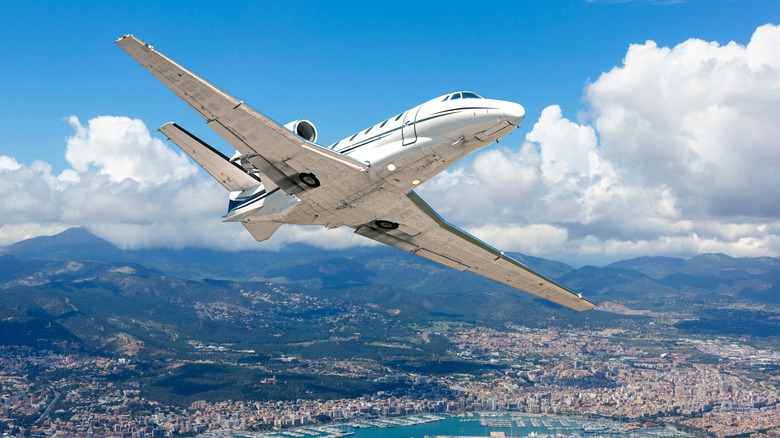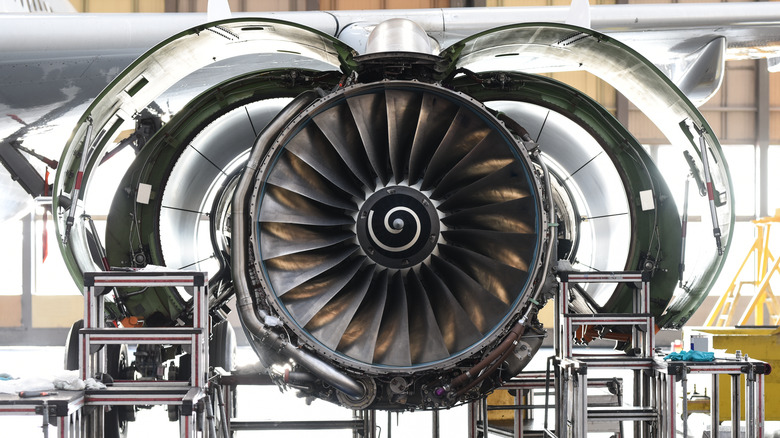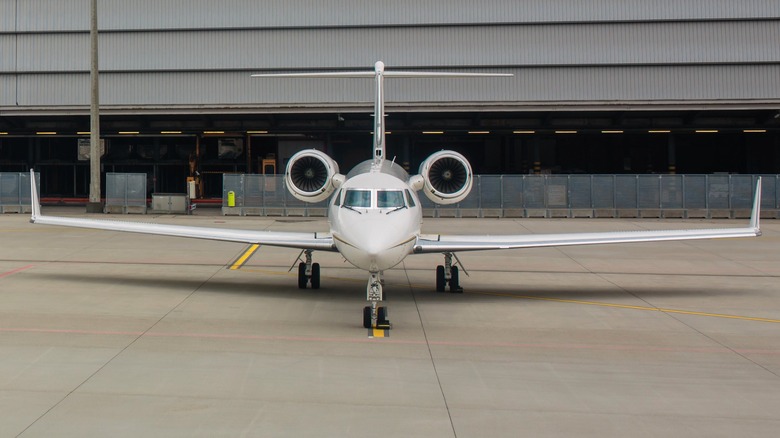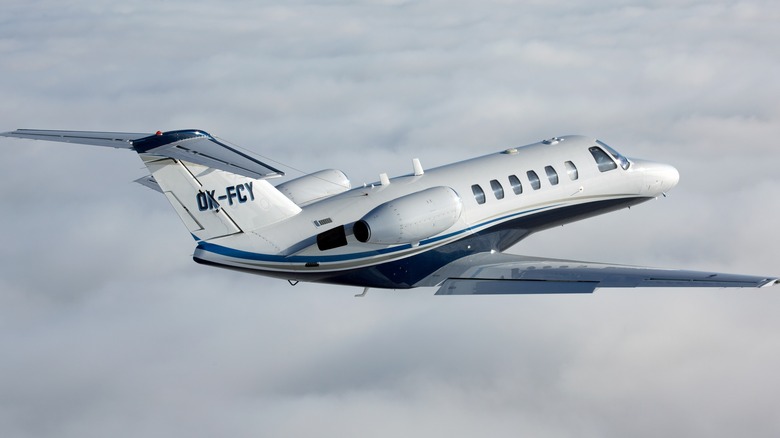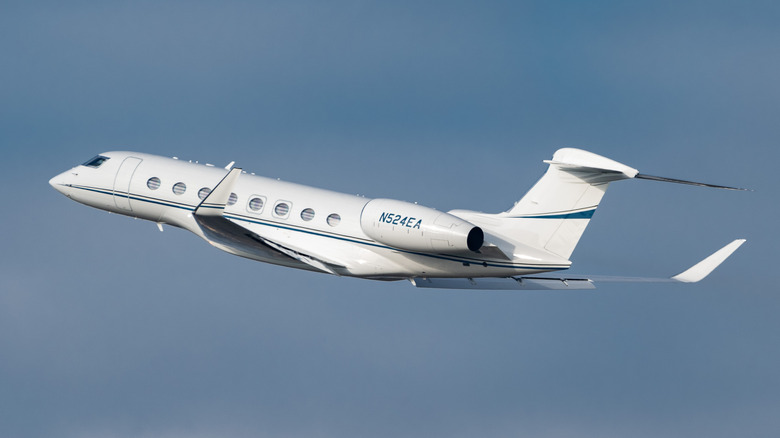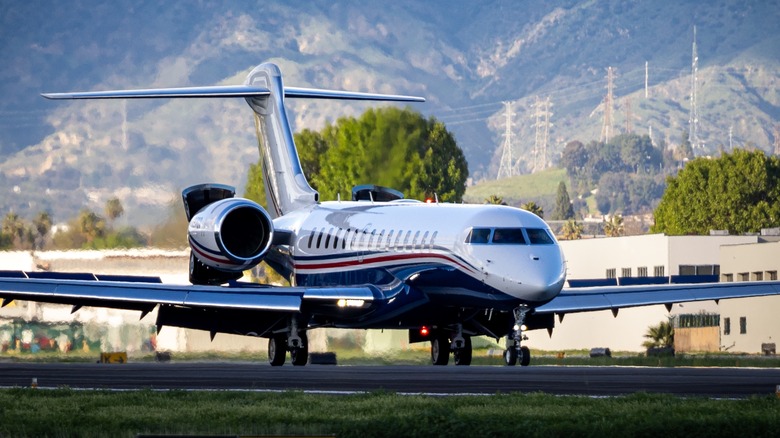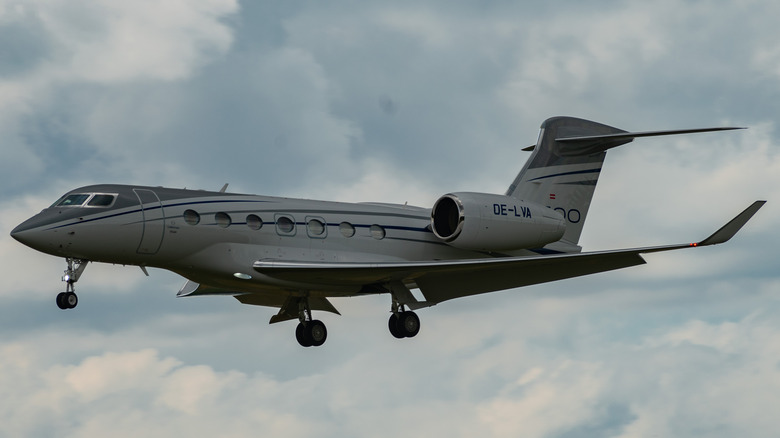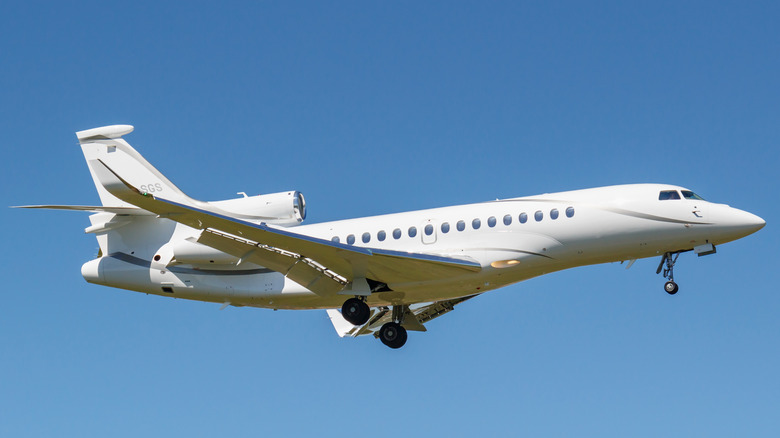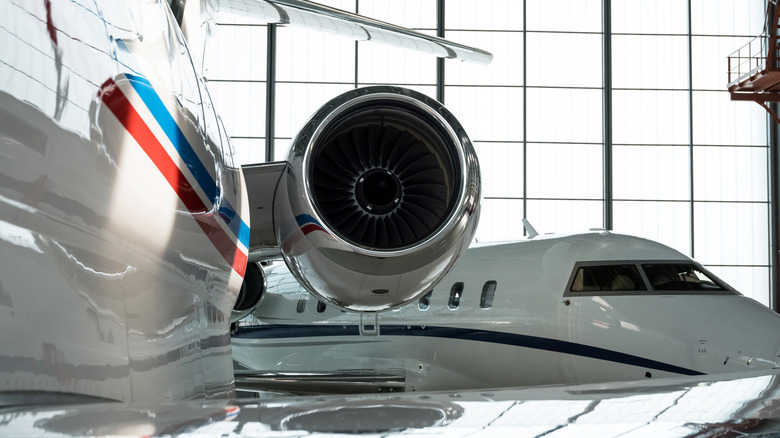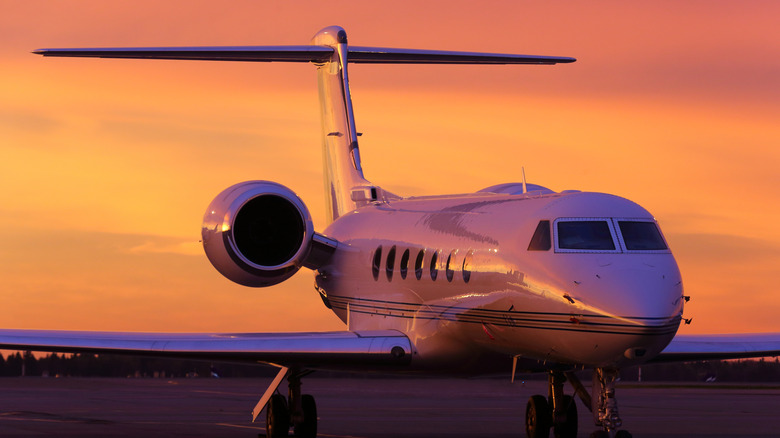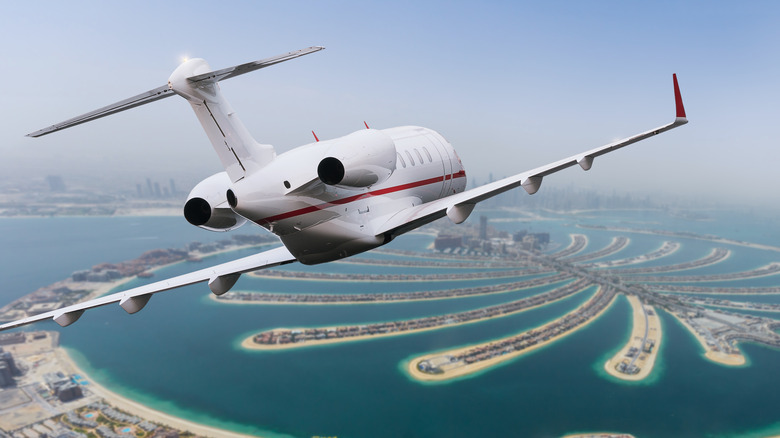Speed Demons: 9 Of The Fastest Private Jets In The Sky Today
There's no doubt that the life of the wealthy involves many benefits not available to ordinary folks. Access to VIP sections, World Series tickets, the best restaurant seats, the coolest cars out there, and fabulous homes are just a few of the perks. However, despite how much it costs, owning a private jet is perhaps the ultimate level of convenience and status. Airplanes are still the safest way to travel; celebrities use private jets to fly around the world without the worry and inconvenience of being mobbed in the airport. Executives use them to keep tabs on vast business empires. Politicians use them for diplomatic trips.
A private jet can whisk you directly to wherever you want to go in a fraction of the time it would take to arrive commercially. Forget the lines at the TSA, or waiting at baggage claim — you can skip the onerous chores of traveling and fly just as fast as a commercial airline. Some private jets fly even faster than that.
So, if getting from Point A to Point B faster than anyone else is essential, which private jets do the job best? To find out, here's our list of 10 of the fastest private jets in the sky today.
Measuring power and speed
Deciphering a jet's performance specs can be a tad tricky. Aircraft essentially need two things to fly: lift and thrust. Wings provide lift by creating an area of low pressure as air flows over them. Create more lift than you have weight and you're airborne. But another force at work wants to bring your airplane to the ground: drag. To defeat drag, an aircraft needs thrust.
Airplanes must use thrust to overcome their drag the same way lift overcomes its weight. Most jet engines, therefore, are rated by the amount of thrust they provide, as it is a direct measure of how much a jet can carry and how fast it can take it. This brings us to Mach. Yes, when you ride a commercial jet, the speed is measured in miles per hour, but most aviation buffs speak in terms of Mach, or the speed of sound. Chuck Yeager taught us that sound travels 767 miles per hour — or Mach 1. The aviation industry measures aircraft speed in relation to Mach. So, double the speed of sound, or 1534 mph, is Mach 2, while half of it, 384 mph, is Mach 0.5.
When an aircraft goes fast enough for supersonic flight, it creates a sonic boom, which is against the law in many countries for civilian aircraft. Therefore, private and commercial jets stay below that magical Mach 1 number.
Learjet 75
Everyone has a budget, and if the heavy-duty speed demons put too much of a crunch on the wallet, the frugal millionaire can opt for the Learjet 75. With a 2019 list price of a mere $14 million, the 75 might not be able to accommodate an entire baseball team, but it should still get you and six of your closest friends to Vegas lickety-split.
The Learjet 75 is a mid-sized jet with a relatively manageable estimated per-hour cost to fly of $1,785. For reference, heavy-duty private jets can cost up to $7,500 per hour. Powered by a pair of Honeywell TFE731-40BR jet engines with 3,850 pounds of thrust each, the 75 isn't going to break any records, but it's no slouch in the speed department. A max cruise speed of Mach 0.67 and a range of 2,040 nautical miles can see it across most of North America in a matter of hours.
Cessna Citation X+
One of the most recognizable names in private aviation, Cessna has been producing models of the Citation since 1972. Over the years, the jet has undergone several revamps, upgrades, and redesigns. Considered a Supermidsized jet, the Citation X+ may not be able to keep up with the heavies and their larger engines, but it's still a performer.
Back in 2014, the Citation X+ earned the title of the fastest jet in general aviation by setting speed records for its 3-leg trip from Wichita to Seattle to Miami and back in the space of a single day. Cessna discontinued the Citation X+ after delivering only 29 of the updated airframes. The upgrades included a pair of Rolls Royce AE 3007 engines delivering 7,034 pounds of thrust each.
With a max speed of Mach .0935, Cessna's claim to be the fastest business jet in the sky has some credence. However, the max cruise speed is a more sedate 528 knots, or Mach 0.79. Still, for a midsize jet, the Citation X+ enjoys respectable speed while hauling up to 9 passengers and a crew of 2 to a range of 3,880 miles.
Gulfstream G650ER
Gulfstream is one of the best private jet manufacturers in the world, so it's no surprise that it produces some of the fastest jets in the sky today. Favored by executives and celebrities alike, the Gulfstream 650ER is famous for its customizable interior, high speed, and excellent range.
The ER stands for extended range, giving the 650ER the ability to travel 500 nautical miles farther than the standard G650. Of course, that number varies based on how heavily laden it is, but the G650ER can carry as many as eight passengers and four crew up to 7,000 nautical miles (about 8,000 miles) in a single leg — that's nearly a third of the way around the globe at the equator!
Dual Rolls Royce BR725 A1-12 engines give the aircraft up to 17,000 lbs of thrust each. But how fast does that translate to? The maximum speed for the GR650 is Mach 0.925, about 93% of the speed of sound, or 710 mph ground speed. However, top speed is not cruise speed, and it's never a good idea to run your jet at top speed for an entire flight. High-speed cruise on the G650ER is set at Mach 0.90, while the more fuel-efficient long-range cruise speed is Mach 0.85.
Bombardier Global 7500
The top of the Bombardier line is not just one of the largest and longest-range jets in the world; it's also amongst the fastest. Bombardier has four separate living spaces, a suite just for the crew (can't have them harshing your vibe with their spatial needs), and a full-size kitchen. With 2,637 cubic feet of interior volume, It's essentially an apartment in the sky with a $72 million price tag and a $6,000 per hour maintenance cost.
For that price, owners can take up to 19 passengers and between two and four crew members up to 7,700 nautical miles without refueling. A pair of GE passport engines give a combined 38,000 pounds of thrust, pushing the Global 7500's top speed in line with other heavy private jets. The Bombardier is capable of reaching Mach 0.925. Its average cruising speed is a tad slower, but still plenty fast, at Mach 0.85.
Gulfstream G500
The Gulfstream G500 may be the little sibling of the G650, but that doesn't mean it's slow. The G500 offers a high-speed cruise equal to the 650ER. First tested in 2015, the G500 is a tad smaller than the 650, with a total interior length of 47 feet. It accommodates up to 13 passengers, with sleeping space for as many as 6, depending on the buyer's chosen layout.
The G500 is powered by a pair of high-thrust Pratt and Whitney PG814GA engines, each of which produces around 15,000 pounds of thrust. Not quite as much as the G650ER, but with less plane to push, the engines are enough to deliver a top speed of Mach 0.925. Normal cruise speed has the G500 cutting through the air at Mach 0.85 and an economy cruise of Mach 0.73.
Slower speed means increased range, and with the proper configuration, the G500 is capable of nonstop flight between Seattle and Seoul. Though less impressive than the long-range 650ER's 7,000 nautical mile range, the possibility of traveling 5,300 nautical miles without refueling is respectable.
Dassault Falcon 8x
French aviation company Dassault not only has a place defending the skies of Europe with its Rafale fighter jet; it also builds a series of highly regarded business jets. While the Dassault Falcon 10x promises next-generation performance, the 8x has been delivering premium speed and range to discerning private jet owners since 2016.
The Falcon 8x has a range of 6,450 nautical miles (7,422 miles), nearly on par with the G650, and reaches a top speed of Mach 0.925. The Dassault 8X can connect New York to Beijing or London to Singapore without refueling.
The plane's high-speed cruising clocks in at Mach 0.90, while long-range cruising hits Mach 0.85, making it as fast as any private business jet of its generation. Unlike many of the jets on this list, the Falcon 8x has a triple-engine configuration with a trio of Pratt and Whitney PW307Ds, each supplying 6,722 pounds of thrust.
Bombardier Global 8000
A new generation of private jets promises more range, higher speeds, and larger capacities, and the Global 8000 delivers. Bombardier's new flagship boasts a top speed of Mach 0.94, a tick faster than the previous generation. It may not seem like much compared to the Mach 0.925 to Mach 0.93 range of its older brethren, but its cruise speed makes the most significant difference.
The dual GE Passport 20 engines each deliver 16,500 pounds of thrust, which can propel the jet at an ultra-high speed cruise of Mach 0.92, not far from its overall top speed. High-speed cruise hits Mach 0.90 and a typical cruise speed sits at Mach 0.85. What's particularly interesting for the frugal private jet owner is that these incredible speeds are possible with an overall reduction in fuel burn of about 8% — pretty substantial savings without sacrificing speed.
Another benefit of the Global 8000 is its increased range. Although its capacity of 19 passengers is no greater than previous iterations of the Global line, a top-of-class 8,000 nautical miles makes the Global 8000 genuinely global.
Gulfstream G700
Gulfstream's upcoming addition to its heavy private jet stable is just a touch shy of the Bombardier Global 8000's promise. Its top speed of Mach 0.935 and 7,750 nautical mile maximum range set it high in its category, while just missing the new Bombardier's high water mark.
A pair of Rolls Royce Pearl engines create 18,000 pounds of thrust each and carry it along at a comfortable Mach 0.90 cruise speed, and Mach 0.85 for long-range cruising. The G700 may not reach the highest echelons of speed, but it has the most extended cabin at 57 feet, with 8 feet of space from beam to beam and a maximum height of 6 feet, 5 inches.
Gulfstream lets clients choose their own layout, with up to five separate compartments, including a possible master suite with a shower. The G700 will require a crew of three to operate, which shouldn't be surprising considering it is one of the largest private business jets available.
Dassault Falcon 10 X
Dassault's most modern entry into the private jet market is in the sky, but it won't be available to consumers until 2025. Set to compete with the Bombardier Global 7500 and Gulfstream G700, the Falcon 10X will have a top speed of Mach 0.925 and be able to fly 7,500 nautical miles, making a hop between New York and Paris or Los Angeles possible.
All this greatness comes at a steep cost of $75 million, but Dassault claims it will offer more interior modularity than any other aircraft in its class. Its interior has the most significant dimensions: a cabin width of just over 9 feet and a 6-foot-8-inch height clearance.
The Rolls Royce Pearl 10X engines are still under development but represent the largest and most potent of the Pearl series, each delivering 18,000 pounds of thrust. Traveling at Mach 0.85, the 10x can carry up to eight passengers and four crew up to 7,500 nautical miles.
